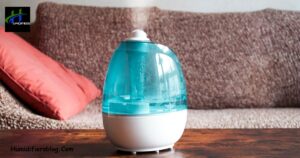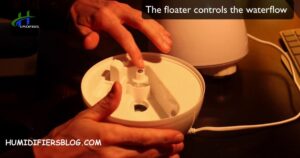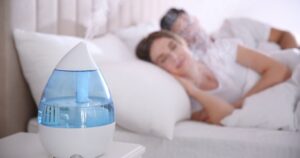A humidifier in the house is a device designed to add moisture to the air within an indoor environment. This can be particularly beneficial in areas where the air tends to be dry, aiding in the prevention of issues such as dry skin, irritated respiratory passages, and static electricity buildup.
When to turn on the humidifier in the house? is a common question that arises as individuals seek to create a comfortable indoor environment. Determining the right time to use a humidifier depends on various factors, including the season, weather conditions, and the overall humidity level in your home.
Understanding when to turn on the humidifier in the house is crucial for reaping its full benefits. During colder months, when heating systems often lead to drier air, it’s advisable to start using the humidifier. If you notice symptoms of dry air discomfort, such as dry skin or respiratory irritation, turning on the humidifier can provide relief.
Why is Humidifier Usage Important in Maintaining Indoor Comfort?
Humidifier usage is crucial for maintaining indoor comfort by adding moisture to the air. Dry indoor air can lead to discomfort, causing issues like dry skin and irritated respiratory passages. A well-maintained humidity level promotes a more pleasant living environment.
When the air inside becomes too dry, turning on your humidifier becomes important. It helps alleviate dry air symptoms, ensuring your home remains comfortable. Regularly using a humidifier during dry seasons and monitoring humidity levels contributes significantly to maintaining optimal indoor comfort.
Determining Optimal Humidity Levels for Your Home with a Humidifier

Maintaining the right humidity in your home is crucial for comfort and health. Humidifiers help achieve this balance by adding moisture to the air. To determine optimal humidity levels, consider the recommended range of 30-50%. Using a humidifier allows you to adjust and maintain this balance, preventing issues like dry skin and respiratory irritation.
When it comes to using a humidifier, understanding the ideal humidity level for your home is essential. The sweet spot falls between 30-50%, striking the right balance for comfort and well-being. By incorporating a humidifier, you gain control over your indoor environment, ensuring that it remains within the recommended humidity range.
Benefits of Turning On Your Humidifier During Dry Seasons
Turning on your humidifier during dry seasons, like winter, offers numerous benefits for your home environment. Humidifiers play a crucial role by adding moisture to the air, effectively preventing issues such as dry skin and respiratory irritation. By ensuring optimal humidity levels, you not only create a more comfortable living space but also extend the life of your Humidifier filter, ensuring its efficiency in maintaining a healthy and balanced indoor atmosphere.
During dry seasons, the air tends to lack moisture, leading to discomfort. Using a humidifier helps combat the effects of dry air, reducing the likelihood of dry skin and irritated respiratory passages. Optimal humidity levels can alleviate static electricity buildup, contributing to a more pleasant atmosphere in your home.
| Benefits | Description |
| Moisturizes Air | Adds moisture to dry air, preventing dry skin and respiratory irritation. |
| Comfortable Living Space | Maintaining optimal humidity levels creates a more comfortable environment in your home. |
| Alleviates Static Electricity Buildup | Helps reduce static electricity, contributing to a more pleasant atmosphere. |
| Combats Effects of Dry Air | Using a humidifier during dry seasons helps prevent discomfort associated with dry air. |
How Can Humidifiers Alleviate Symptoms of Dry Air Discomfort?
Humidifiers play a crucial role in alleviating symptoms caused by dry air discomfort. By adding moisture to the air, these devices prevent issues like dry skin and irritated respiratory passages, promoting a more comfortable indoor environment.
Considering “When To Turn On Humidifier In House?” is essential for maintaining optimal humidity levels, especially during dry seasons. Using a humidifier helps alleviate discomfort by ensuring the air in your home stays sufficiently moist, reducing the likelihood of dry skin and respiratory irritation.
When you turn on a humidifier in your house, it releases water vapor into the air, increasing humidity levels. This added moisture prevents the air from becoming overly dry, reducing the likelihood of dry air symptoms. As a result, using a humidifier proves effective in addressing discomfort associated with low humidity, ensuring you and your family can enjoy a more pleasant living space.
When Should You Consider Using a Humidifier in Your House?
When the air feels dry and uncomfortable, consider using a humidifier in your house. It helps maintain optimal humidity levels, preventing issues like dry skin and irritated airways. Turning on the humidifier during dry seasons ensures a more comfortable indoor environment.
Humidifiers are particularly useful when weather conditions lead to low humidity. When should you consider using a humidifier in your house? During colder months and in dry climates, it helps combat the effects of heating systems and external factors, providing relief from dry air discomfort.
Factors Influencing the Decision to Turn On Your Humidifier
Determining when to turn on your humidifier involves considering various factors. Seasonal changes, especially during colder months, often lead to drier indoor air. Monitoring the weather conditions and noting when your home’s air feels excessively dry are key indicators to switch on the humidifier.
Paying attention to your comfort level and any signs of dry air discomfort, such as skin dryness or respiratory irritation, guides the decision. Humidifier usage becomes essential when these factors align, creating a more pleasant and healthier indoor environment.
Understanding the Impact of Weather Conditions on Humidifier Usage
Weather conditions play a crucial role in determining when to turn on the humidifier in your house. During colder seasons, the air tends to become drier, and heating systems can further contribute to a decrease in humidity levels.
The impact of weather on humidifier usage is particularly noticeable in regions with harsh winters. As temperatures drop, the air loses moisture, leading to an environment that can cause discomfort such as dry skin and respiratory irritation.
Maintaining Healthy Indoor Air Quality through Humidifier Control
Humidifiers play a crucial role in maintaining healthy indoor air quality. By controlling the humidity levels in your home, these devices help prevent issues like dry skin and irritated respiratory passages.
Understanding when to turn on your humidifier is essential for effective control. During dry weather, such as winter, using a humidifier becomes beneficial in preventing the air from becoming excessively dry. This proactive approach contributes to the overall well-being of your indoor environment, supporting a healthier and more comfortable living space.
Practical Tips for Effective Humidifier Management in Your Home

Maintaining the right humidity in your home is crucial for comfort. When considering practical tips for effective humidifier management, start by understanding your home’s optimal humidity level. Check the manufacturer’s recommendations for your humidifier model to ensure you provide the right amount of moisture to the air.
Once you’ve determined the ideal humidity level, regularly monitor and adjust your humidifier settings accordingly. During dry seasons, such as winter, turn on the humidifier helps prevent issues like dry skin and irritated respiratory passages.
Place the humidifier in central areas of your home for even distribution, and clean it regularly to avoid bacteria buildup. Following these practical tips ensures your humidifier effectively contributes to a healthier and more comfortable living environment.
FAQ’s
What months should you use a humidifier?
As with adults, it is best to incorporate a humidifier during both the winter months and summer months or when your home hygrometer reads below 40%. You can also introduce a humidifier for babies when you notice signs of minor nasal congestion.
Is it OK to leave humidifier on all night?
Running your humidifier all night is perfectly safe, there are humidifier safety tips to bear in mind: Monitor your home humidity levels: The optimal home humidity levels range from 40% to 60%.
Where is the best place to put a humidifier?
A quality humidifier should work well and distribute water vapors evenly throughout the room from any reasonable location, placing your humidifier on a central, elevated surface like a high table or countertop would be ideal.
Is humidifier good for cough?
Humidifiers help moisturize your lung, throat, and nasal passages. The CDC (Centers for Disease Control and Prevention) suggests that by helping loosen mucus, a cool-mist humidifier can soothe coughs.
Conclusion
Humidifiers prove to be valuable devices by adding moisture to the air, preventing issues like dry skin and irritated respiratory passages. The decision to use a humidifier depends on factors such as the season, weather conditions, and overall humidity levels in your home.
By incorporating practical tips, such as monitoring humidity levels, adjusting settings, and proper placement, you can effectively manage your humidifier for optimal results. Whether during dry seasons or colder months, turning on the humidifier becomes essential for preventing discomfort associated with low humidity.










